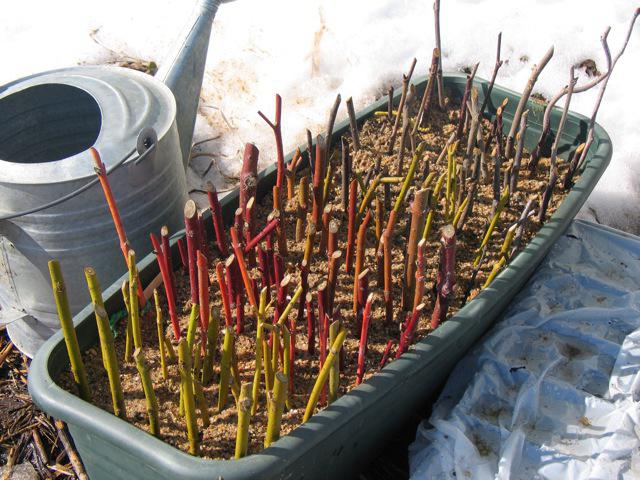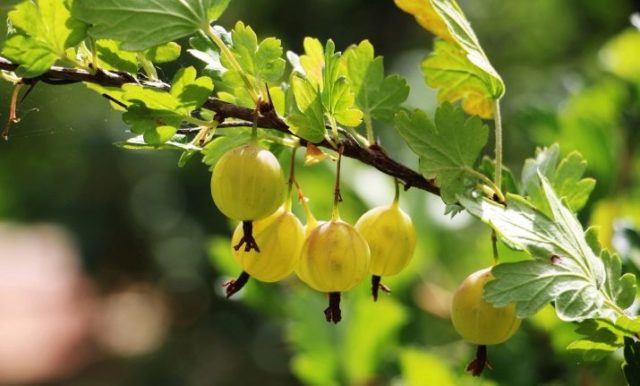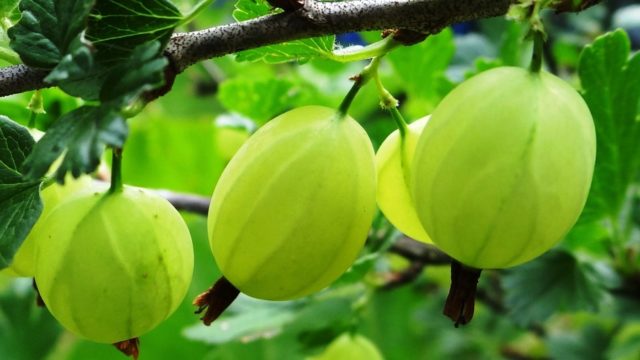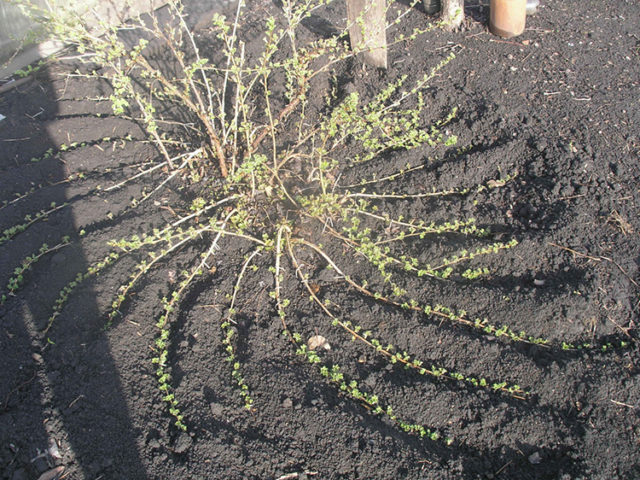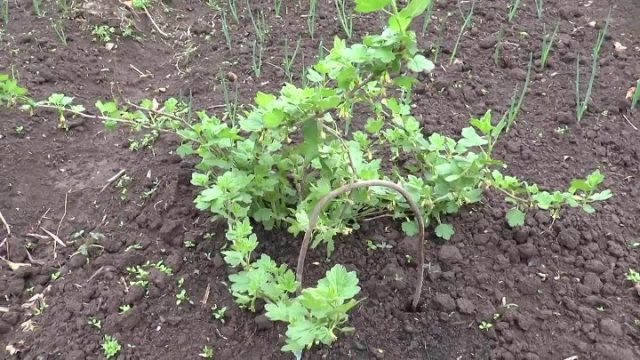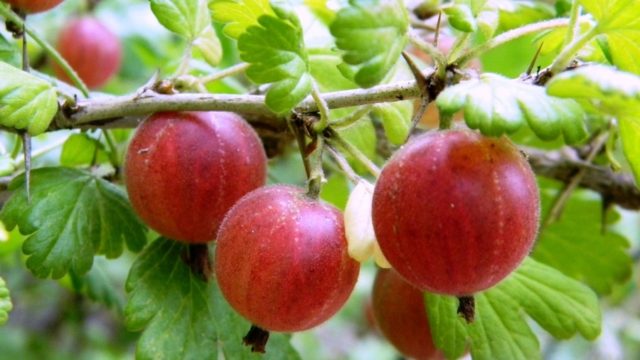Content
- 1 How gooseberries reproduce
- 2 When is it better to propagate gooseberries: in spring, summer or autumn
- 3 How to propagate gooseberries by cuttings
- 3.1 Recommended timing
- 3.2 Harvesting green and lignified cuttings
- 3.3 Selection of containers and soil preparation
- 3.4 Gooseberry propagation by green cuttings
- 3.5 Gooseberry propagation by lignified cuttings
- 3.6 How to root a gooseberry stalk in spring in water
- 3.7 Growing and transplanting to a permanent place
- 4 How to propagate gooseberries by layering
- 5 Gooseberry propagation by dividing the bush
- 6 How to propagate gooseberries by offspring
- 7 Is it possible to propagate gooseberries by seeds
- 8 Is it possible to propagate gooseberries by grafting
- 9 How can you propagate gooseberries without thorns?
- 10 Conclusion
You can propagate gooseberries with green cuttings in summer without much effort if you know the basic rules of procedure. The garden fruit shrub lends itself very well to reproduction, in several different ways you can significantly increase its number on the site.
How gooseberries reproduce
Gooseberry is a very popular horticultural crop. With proper care, the shrub yields abundant tasty fruits, multiplies very easily, so usually gardeners densely plant the plant on the site using proven propagation methods.
There are several ways to propagate gooseberries.
- By seed method - it is not difficult to propagate a plant from seeds, but the method is not very popular. The fact is that the characteristics of the parent variety in the new bush are not preserved.
- By cuttings - both green and lignified cuttings are used for rooting. The method is most popular among gardeners, since it practically guarantees the successful rooting of a new plant.
- By dividing the bush - this method makes it possible to propagate overgrown shrubs over the site.
- Layers - Long flexible gooseberry shoots are well suited for horizontal or apical rooting in the ground near the mother bush.
Gooseberries can be propagated by offspring at the roots and by grafting. The choice of a particular method depends only on one's own preferences and some external conditions.
When is it better to propagate gooseberries: in spring, summer or autumn
Gooseberries can be propagated throughout the warm season. The choice of timing directly depends on the method by which it was decided to propagate the shrub.
- It is more convenient to propagate gooseberries by layering in late spring or summer, at the height of the growing processes.
- You can propagate gooseberries by dividing the bush in spring or autumn. In the spring, it is necessary to divide a large bush before the plant begins to actively build up its green mass, and in the fall it is necessary to have time to divide it from the beginning of September to the beginning of October.
- Gooseberry cuttings are carried out in early summer, from early June to July.
- It will be possible to propagate the gooseberry by root suckers in the fall, after the end of all the main work and harvesting. The ideal time is the beginning of October, when there are still 2-3 weeks before the first frost.
If it is decided to propagate gooseberries by seeds, then they are collected during the fruiting period, sown in closed containers with the onset of cold weather and kept in a cool place throughout the winter.Seed-derived gooseberries are transplanted into the soil in the spring, usually containers with seedlings are transferred into the soil no earlier than April.
How to propagate gooseberries by cuttings
It is the easiest way to propagate a fruit shrub by cuttings, since almost any plant varieties demonstrate good rooting.
- The highest rooting rate is in the American-European hybrid varieties, such as Russian, Eaglet, Medovy - up to 90%.
- Free-pollinated European varieties - Timiryazevsky and Granatovy, Slavyansky and Muscatny - show lower rates - an average of 30-50%.
- The worst way to propagate by cuttings is the European varieties Triumfalny, Brazilian and Varshavsky.
If it is decided to propagate the plant with green shoots, then the best time for their rooting will be summer, if the shoots are lignified, then autumn. It is recommended to propagate the shrub by cuttings in closed home containers, you can also use greenhouses with high temperatures and high levels of humidity. The process looks quite simple - first, the shoots are kept in water with the addition of a stimulating solution, and then they are buried in the ground and wait for the first roots to appear.
The advantage of the method is, first of all, that it is very easy for it to get planting material if there is at least 1 gooseberry bush on the site. Gardeners are almost unlimited in terms of the procedure, and besides, cuttings are somehow familiar to summer residents and rarely causes difficulties.
Recommended timing
If green young shoots are taken for propagation of gooseberries by cuttings in the spring, then they are harvested at the end of spring, while the branches have not yet had time to be covered with strong bark. Lignified shoots are cut both in spring and autumn, in the first case this should be done in April, and in the second in mid-October.
Harvesting green and lignified cuttings
When harvesting shoots, the main rule must be observed - the material for propagation of gooseberries must be healthy and strong.
- If you need to propagate the gooseberry with green shoots, then in the summer, in June or early July, several young branches from 8 to 15 cm long are cut from an adult shrub. It is best to take the apical branches, they take root faster, and harvesting is best done on a cloudy day and early in the morning.
- If in order to propagate the gooseberry, lignified shoots are needed, then they are cut in the fall in September-October. The length of the branch should also be from 8 to 15 cm, and cuttings from the upper part of the shoot take root much better and faster than from the lower one.
In order for the cut shoots to remain healthy, it is recommended to treat them with a weak solution of potassium permanganate immediately after harvesting - this will prevent rotting.
Selection of containers and soil preparation
It is best to root cuttings in small pots at home. At the bottom of the pot, it is necessary to equip a good drainage from expanded clay, small pebbles or broken brick. It is not recommended to take too large a pot for escape. The earth in it can acidify, it is better, if necessary, to transplant the grown seedling into a larger container.
Gooseberry soil should be loose, nutritious and well hydrated. Usually, sand, peat and fertile soil are mixed in equal proportions; in such conditions, the shoot takes root the fastest.
Gooseberry propagation by green cuttings
Before planting in the ground, it is recommended to keep green shoots in a solution that stimulates root growth for a day, so they will take root more quickly. On the video of the propagation of gooseberries by cuttings in the summer, you can make sure that the further algorithm looks like this:
- the prepared planting material is buried in the soil in pots so that a pair of buds remain above the ground;
- the shoots are properly watered, and then immediately cover the pot with a glass cap or plastic wrap - this will maintain the desired humidity;
- the constant temperature in the room with shoots should be at 23 ° С during the day and at least 16-18 ° С at night;
- under the film or hood, the temperature should not rise above 25 ° C, otherwise the cuttings can rot, in order to avoid this, the film must be regularly lifted and ventilated.
Subject to all the rules for the propagation of gooseberries with green cuttings in summer, the plant will give its first roots after 2 weeks, and in the fall it can be transplanted under the open sky.
Gooseberry propagation by lignified cuttings
If lignified shoots are used, then gooseberry propagation by cuttings in the fall is used. True, it should be noted that cuttings are cut in October, and then they start growing traditionally in early spring. Therefore, during the winter, the cuttings must be properly stored, after harvesting, they are kept in a growth stimulator for a day, then wrapped in a damp cloth, packed in a plastic bag and sent to the refrigerator. During the winter, the fabric is re-moistened from time to time, while the bag must be kept open so that the humidity remains at the desired level.
With the onset of spring, cuttings are rooted in prepared containers in soil consisting of fertile soil, sand and peat. The material is deepened at an angle of 45 °, 2-3 buds should remain above the ground. Immediately after planting, the cutting should be watered and covered with a film or glass cap, and 2 weeks after the formation of the first roots, the film should be removed and the usual care should be carried out in the future.
How to root a gooseberry stalk in spring in water
Propagation of gooseberries by cuttings in spring in water is usually used for lignified shoots, this stimulates them to grow faster. At the end of February or in March, cuttings must be placed in narrow containers filled with clean soft water and left in a room with a temperature of at least 23 ° C.
Soon, vegetative processes begin on the cuttings, and young leaves appear in the upper part of the shoot, and roots in the lower part. To multiply the plant faster, you can keep the shoots in a growth stimulator for an additional day, and only then rearrange them in plain clean water. As the water evaporates, it is not necessary to change it entirely, you can simply add fresh water as needed.
Growing and transplanting to a permanent place
It will take several weeks to propagate the plant by cuttings, after which the young shoots are actively launched into growth. Since the cuttings are usually transferred to the ground in June or early July, in order to successfully propagate them, during the spring the shoots will have to be grown in pots. It is quite simple to do this - after the film is removed from the pot, the soil will need to be moistened as it dries, and the pots themselves should be kept in a well-lit, warm place.
To land in open ground, it is necessary to select a sunny, open area located not far from any structure or fence - the gooseberry needs a cover from the wind. The site should not be excessively wet, if groundwater passes nearby, then you will have to first attend to the creation of high-quality drainage.
- Planting holes for seedlings are dug 3 weeks before planting, in size they should be about half a meter in depth and the same in diameter.
- If you plan to multiply gooseberries abundantly and plant several bushes at once, you should leave 1 m of space between them and 2 m between rows of shrubs.
- Soil for gooseberries in the open field should be fertile - it is recommended to mix the soil from the site with 10-15 kg of humus or compost. Also, you need to add phosphorus and potash fertilizers to the soil.
It is better to plant gooseberry bushes obtained by cuttings in a checkerboard pattern, so that later they do not obscure the light to each other. Immediately after planting, the seedlings need to be watered and mulch the soil in the near-stem circle with a dense layer of 5 cm.
How to propagate gooseberries by layering
Best of all, it is possible to propagate European gooseberry varieties by layering, which are not very readily amenable to cuttings. The procedure should be carried out in late spring or summer, when the gooseberry is in a state of active vegetation.
The main advantage of layering is that they allow gooseberries to propagate directly in the open field, without transplanting from a closed container. In addition, the instructions for vegetative propagation by layers of a gooseberry bush are very simple.
Gooseberry propagation by apical layers
For the apical layers, in the spring at the gooseberry, you need to pinch several young shoots about 45 cm long so that they give new lateral shoots, and then pinch them too. It is necessary to build up potential layers on the gooseberry in this way until mid-summer.
In July, the selected apical shoots will need to be bent to the ground and a 10 cm deep groove should be dug out where the tops touch the ground. The tops of the shoots are laid in the ground, fixed with a wire or staple. Then you need to dig in the gooseberries for breeding and water abundantly.
You don't need to do anything special, you just need to regularly water the cuttings along with the main bush. After about 3 weeks, new shoots will appear from the soil, and in the middle of autumn they can be carefully dug up and transplanted to a permanent place.
How to propagate gooseberries with horizontal layers
Vegetative propagation by layers of the gooseberry bush using the horizontal method is a simple process. The algorithm looks like this:
- at the beginning or middle of summer, several young shoots up to 3 years old are chosen, located close to the ground;
- on each branch, the fresh growth is shortened by about a third - this stimulates the growth of lateral buds;
- shoots are bent to the soil and laid horizontally in shallow trenches, and then fixed with wire in several places and covered with earth.
Immediately after this, the layers need to be watered and mulched, after a couple of weeks complex fertilizers can be applied. After sprouts appear from the ground, it will be possible to huddle them a little, and after another 2 weeks, hilling them can be repeated. With proper care, by the fall, the layers take root strong, in October they can be separated from the mother bush and transferred to a new place.
Gooseberry propagation by dividing the bush
When dividing the bush, almost all varieties of gooseberries take root well, and hybrid American-European varieties take root most quickly. It is recommended to use division for especially valuable varieties - the fact is that you can propagate gooseberries in the fall in this way without losing varietal characteristics.
Bushes that have reached 2 years or more are suitable for dividing, and gooseberry propagation is carried out in the fall - in October and November.
It is very simple to propagate a plant by dividing a bush, for this you need:
- gently dig a gooseberry bush from the ground;
- with a sharply sharpened shovel, divide its rhizome into several parts;
- disinfect the slices, and then transfer the cuttings to new places and plant them in the prepared wells according to the standard algorithm.
Each of the divisions should have several intact strong roots and 2-3 well-developed shoots. The advantages of the method are that you do not need to spend time rooting a plant from scratch, gooseberries have roots initially. With proper care, the bushes take root in new places very quickly.
How to propagate gooseberries by offspring
Both European and American varieties can be propagated by offspring or root growth that grows naturally around the bush.
It is recommended to propagate gooseberries by offspring in the fall, after fruiting. Young shoots in the roots of plants must be carefully separated from the main bush and transferred to a new place in pre-prepared holes. The shoots are planted directly into the ground; it is not necessary to root the offspring in pots beforehand.
The advantages of the method are that gooseberries can be propagated in this way quickly and without additional hassle associated with cutting and rooting cuttings.
Is it possible to propagate gooseberries by seeds
Any varieties of gooseberries can be propagated by seeds collected from the fruits of the plant. However, in practice, this method is rarely used. Despite the fact that seed propagation is quite easy, and the planting material does not even need to be additionally prepared, the method has its drawbacks. First of all, after seed reproduction, gooseberries do not retain varietal characteristics; this method can only bring out a new variety. In addition, the first fruiting in a bush occurs only after a few years.
To propagate gooseberries by seeds, you must:
- collect ripe berries in July-August and extract seeds from them;
- dry the seeds for several days, and then immediately sow in small pots filled with sand, humus and fertile soil in equal proportions;
- water the seedlings and cover them with foil, then put them in a cool place with a temperature of up to 5 degrees.
It is necessary to keep the seedlings cool, regularly moisturizing them, until spring. After warm weather is established, the pots are taken out into the garden and buried entirely in a temporary area - you do not need to remove the earthen lump from the pots. After the first shoots of the gooseberry give 2 leaves, the seedlings can be dived and transferred to a permanent place.
Is it possible to propagate gooseberries by grafting
In rare cases, it is advisable to propagate gooseberries by grafting - under a favorable coincidence, this allows you to grow a shrub on a strong stem, improve the decorative appearance of the plant and increase the size of the fruit. True, the method also has disadvantages - the yield of the grafted gooseberry is usually low, you have to take care of the plant more carefully, and the health of the gooseberry depends on the stem.
Inoculation is carried out on fruit bushes, less often on trees. Mainly currants, sometimes plums or even mountain ash are used as a stock.
The grafting is carried out as follows - a wedge-shaped cut is made on the scion, and the same split on the rootstock, the plants are combined with each other and fixed with a bandage. As the shoots grow on the grafted gooseberry, they will need to be pinched to get a dense crown, and on the rootstock, young shoots must be removed in a timely manner.
How can you propagate gooseberries without thorns?
Selective varieties of gooseberries without thorns are very popular; it is easier to harvest from such a bush. You can propagate gooseberries without thorns by all standard methods, but cuttings bring the best results. In the process of breeding a plant without thorns, it is especially important to monitor the fertility of the soil and often feed the shrub with organic matter and mineral fertilizers.
Conclusion
You can propagate gooseberries with green cuttings in the summer quickly and without unnecessary problems. There are also many other ways to breed shrubs.Which one to choose depends on the season, the gooseberry variety, and the gardener's personal preferences.
